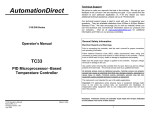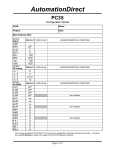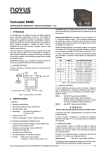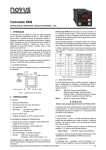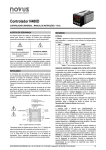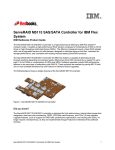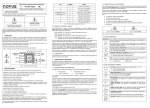Download Econoburn EBWC-500 Technical information
Transcript
AutomationDirect Technical Support We strive to make our manuals the best in the industry. We rely on your feedback to let us know if we are reaching our goal. If you cannot find the solution to your particular application, or, if for any reason you need additional technical assistance, please call us at 770-844-4200. Our technical support group is glad to work with you in answering your questions. They are available weekdays from 9:00am to 6:00pm Eastern Standard Time. We also encourage you to visit our website where you can find technical and non-technical information about our products and our company. Visit us at www.automationdirect.com for additional information and FAQ’s on our process controllers. 1/16 DIN Series General Safety Information Operator’s Manual Electrical Hazards and Warnings Prior to connecting the controller, read the user’s manual for proper connection and operating information. Follow National Electrical Code (NEC) safety requirements when wiring and connecting a power source and sensors or other devices to the controller. Failure to do so could result in injury, death or damage to equipment and property. TC33 Make sure the proper input voltage is applied to the controller. Improper voltage will result in damage to the unit. PID Microprocessor - Based Temperature Controller Use caution when removing the controller from its case, there may be live voltage present at the terminals. This should only be done by a qualified technician. All terminal screws must be tightened securely. Terminal screws not properly secured can cause an electrical short that may damage property, equipment or cause injury or death. Terminal screws improperly secured may fall into equipment causing possible damage to property or equipment. This instrument is not intended for use in life safety applications. Important: For applications where physical injury or equipment damage might occur in the event our product fails, we recommend the installation of independent safety equipment with its own independent sensor that will shut down the process. TC33 Operator’s Manual Manual Rev. 2.2 Firmware Version 1.40 July 2003 Made In USA Important: Firmware version of controller must match the version indicated on the bottom front cover of this manual. 1 TC33 Temperature Controller 1/16 DIN Series TC33 Operator’s Manual Manual Rev. 2.2 Firmware Version 1.4x Table of Contents Description TC33 1/16 DIN - PID Autotune Temperature Controller Page 1. Main Features …………………..…………………………………….… 3 2. Specifications ………………………...……….……………….………..3 Input ………..………………………………………………..…….. 4 PID Control …….…………………….…………………..….…….. 4 Output ……….….…………………………………..……………... 4 2.1 Main Dimensions ……..…………………………………..…….…... 4 3. Operation .…………….…………………………………...……………. 5 3.1 General Electrical Connections ……………………………………6 3.2 Power Wiring ………………………………………..………………. 6 3.3 Input Wiring …………………………..………………………………7 3.4 Standard Relay Outputs …………….………..…………….………7 3.5 Sourcing 4-20mA Output Wiring ……..……..……………………..7 3.6 Panel Assembly …….…..…………………………………….……..8 3.7 Error Messages …..………………………………………….………8 4. Menu System ……………………………………………………………...8 4.1 Initial Startup ……………...…………………………………….……9 4.2 Set Up Cycle Parameters …..…………...……………………….…9 Cycle Menu ………………………..…………………………..…..9 4.3 Digital Serial Number Access …..…………………………….…….9 5. Configuration ……………..………………………………………..…….. 10 5.1 Cycle 1 – Operation …..……………………………………………..10 Ramp & Soak ……………………………….……………….…….11 5.2 Cycle 2 – Tuning & Alarms ……..……….………...………………..12 5.3 Cycle 3 – Input Configuration …...………………………………….13 Alarms Configuration …….…………….…………….……………13 Table 1 – Alarm Functions ….……………………….….…..……14 5.4 Cycle 4 – Calibration …………..……….…………………………...16 5.5 PID Auto-Tune Operation ………...…….………………………...…17 5.6 PID Manual Tuning ………………………………………………….18 Table 2 – PID Manual Tuning ….………………………………..19 Quick PID Set Up Reference …………………………………..……....…. 19 Notes ……………………………………………..…………… ……………...21 Configuration Sheet ………………………………………………………... 22 1. MAIN FEATURES • • • • • • • • • • • • • • • • • 2. SPECIFICATIONS • • • • • • • 2 Temperature multi-sensor input without hardware change. Accepts thermocouples J, K, S, T, N, E, R, and RTD-Pt100. Dual Display: PV (red) and SV (green). Selectable ºF/ºC temperature. RTD-Pt100 with 1º temperature resolution: -328 to 986 ºF (-200 to 530 ºC), and 0.1º temperature resolution: -199.9 to 986.0 ºF (-199.9 to 530.0 ºC). Input sample rate: 10 reading per second (100 ms). Isolated 4 to 20mA linear control output, optional. Ramp and Soak: one controlled ramp and one timed soak are standard. Auto-tuning PID control, or manual PID control, or ON/OFF control with hysteresis adjust. Sensor break protection in any condition. Independent alarm hysteresis adjust. Easy-to-set programming menu. Firmware version displayed during power up. Digital serial number. High impact ABS enclosure. Dimensions: 48x48x106mm. Power: 90 to 260Vac, 50/60Hz. Dimensions: 48 x 48 x 106mm (1/16 DIN) Approximate weight: 200g max. Panel cut-out: 45.5 x 45.5mm (± 0.3mm) Terminal connection: screws, accepting 16 to 24 AWG wires or 6.3 mm fork lugs. Power: 90 to 260Vac, 50/60Hz, Consumption: 7VA max. Operating environment: 0 to 50°C (32 to 122°F), humidity: 10 to 85% RH, noncondensing. Flame-Retardant ABS Plastic Case. Warm-up time: 15 minutes max. 3 INPUT • • • • Keypad selection of input type (refer to Cycle 3). Display resolution: 0.1ºF/C or 1ºF/C (RTD-Pt100). Input sample rate: 10 per second (10Hz). Accuracy: Thermocouples J, K, T, N, E: 0.2% of span, ±1ºC, ±1 digit. Thermocouples S, R: 0.25% of span, ±3ºC, ±1 digit. Pt100: 0.2% of span, ±0.5ºC, ±1 digit. • Input impedance: • Pt100 measurement: 3. OPERATION Operator Interface Thermocouple: >10MΩ DIN 43760 standard (α=0.00385). 3-wire circuit, cable resistance compensation. Excitation current: 170µA. PID CONTROL: • • • • • • User-selectable as: ON-OFF w/ adjustable hysteresis, or manual P, PI, PID and PID-Autotune. Proportional Band (Pb): 0 = ON/OFF control; or 1% to 500% of maximum input span. Integral (Ir): 0 = off; or 0.01 to 25.00 rep/minutes Derivative (Dt): 0 = off; or 1 to 250 seconds. Cycle-Time: 0.5 to 99.9 seconds (for PWM-PID output control). PID-Autotune: start from the front panel. OUTPUT: model TC33-1100-AC: • • Control – C LED: indicates that the controller is active, with control. If there is a control output programmed as PWM or ON/OFF, the output LED will reflect the actual state of the output (ON or OFF). If there is a Linear 4-20mA control output, the LED will be continuos ON. One isolated Linear Control sourcing 4-20mA output @ 500 ohms max. load. Two SPST Relay Alarms (without contact suppression): Resistive: 3A @ 250VAC / 3A @ 125VAC / 3A @ 30VDC Inductive: 2A @ 250VAC / 2A @ 30VDC Dielectric Strenght: 750Vrms between open contacts (at sea level for 1 min.) Auto-Tune – AT LED: indicates that the controller is in Auto-Tune mode, (LED On = Auto-Tune active). Alarm 1 – AL1 LED: indicates the status of the alarm, (LED On = alarm active). Alarm 2 – AL2 LED: indicates the status of the alarm, (LED On = alarm active). 2.1 MAIN DIMENSIONS, AND PANEL CUTOUT: 6 mm 100 mm SET UP key: used to set up menu cycles. Decrease key: used to change parameter values. 45.2 mm to 45.8 mm AT Panel Cutout A1 SET UP (Not to scale) 45.2 mm to 45.8 mm AutomationDirect A2 Process Display - PV: shows the PV (Process Variable) value, and used when configuring the parameters of the controller. Setpoint Display – SV: shows the SV (Setpoint Variable) value, and used when configuring the parameters of the controller. One isolated Pulsed DC Output Control (12Vdc pulsed @ 15mA max.). One SPST Relay Alarm (without contact suppression): Resistive: 3A @ 250VAC / 3A @ 125VAC / 3A @ 30VDC Inductive: 2A @ 250VAC / 2A @ 30VDC Dielectric Strenght: 750Vrms between open contacts (at sea level for 1 min.) OUTPUT: model TC33-2010-AC: • • (Figure 2) Increase key: used to change parameter values. When the controller is initially energized, the firmware version is displayed for approximately 4 seconds, after which the controller starts normal operation. The values of PV (temperature), and SV (setpoint) are displayed and the outputs are enabled after 6 seconds. (Figure 1) 4 5 Before the controller is ready to be used in a given process, it requires some basic configuration, such as: • Input Type (T/C, or Pt100) at the tYPE prompt, section 5.3 (page13). • Output Configuration (control, alarms) at (ntr prompt, section 5.3 (page13). • Setpoint Variable SV. • PID parameters (or hysteresis for ON/OFF control), see Cycle-2 (page12). Other functions, including alarms, ramp to soak, etc., may be useful for a better system performance. 3.3 INPUT WIRING: RTD-PT100 AND THERMOCOUPLE: Sensor Input Thermocouple Sensor Input RTD - Pt100 1 2 3 2 (Figure 5) 3.1 GENERAL ELECTRICAL CONNECTIONS: Model TC33-2010-AC Model TC33-1100-AC TC 1 Rtd 2 3 1 3.4 OUTPUTS: 2 3 13 14 Notes: 1) For Thermocouple Sensors use appropriate compensated thermocouple wires. 2) Use copper conductors rated for at least 75 ºC (except on T/C). TC Rtd 3 TC3X TC3X Two SPST Relay Output (TC33-2010-AC) One Pulsed & One Relay (TC33-1100-AC) 9 10 11 12 9 10 11 12 15 7 8 Power In 90~260 Vac 9 10 11 12 Relay AL-2 7 Relay CONTROL or AL -1 8 Power In 90~260 Vac 9 10 11 12 Relay AL-2 + ALM-2 ALM-1 or CONTROL Relay AL-2 + CONTROL (ON/OFF or PID) (Figure 6) CONTROL 3.5 SOURCING 4-20MA OUTPUT WIRING: (Figure 3) Linear 4-20mA Sourcing Output (TC33-2010-AC) 3.2 POWER WIRING: AC Voltage Power Wiring 4~20mA Linear Control 7 8 Fuse Power In 90~260 Vac 50/60Hz - 13 14 15 (Figure 7) 200mA - Slow Blo Note: The installation of fuse is optional, depending on level of protection required. (Figure 4) 6 NOTE: All terminal screws must be tightened securely. Terminal screws not properly secured can cause an electrical short that may damage property, equipment or cause injury or death. Terminal screws improperly secured may fall into equipment causing possible damage to property or equipment. 7 PANEL ASSEMBLY: 4.1 INITIAL STARTUP: First remove the mounting clamp and insert the controller into the panel cut out. Place the unit into the panel cut out and slide the mounting clamp from the rear to a firm grip at the panel. The internal circuitry can be fully removed from the housing without disconnecting any wiring. By using the thumb, just press the tab in the lower part of the front panel, grab the front panel firmly and pull the front face and circuitry from the housing. Warning: Use caution when removing the controller from its case, there may be live voltage present at the terminals. This should only be done by a qualified technician. It is recommended that power to the controller be disconnected prior to removing the controller from the case. 3.6 ERROR MESSAGES: The connection and configuration errors for most of the problems encountered in using the controller are shown below. A final revision of parameters will save time and further losses. Error messages are displayed to help the user to identify possible problems. : Process temperature is below the selected sensor range. : Process temperature is above the selected sensor range When the controller is initially energized the Firmware version is displayed for approximately 4 seconds in the PV display after which the controller reverts to normal operation mode or Operation Cycle. This is SET UP Cycle-1. The upper display, PV, shows the Process Variable (temperature) and the lower display, SV, shows the Set Point Variable in this cycle. The controller remains in this cycle while under normal operation. Important: Firmware version of controller must match the version indicated on the bottom front cover of this manual. 4.2 GENERAL SETUP CYCLE PARAMETERS: The cycles need only to be accessed when a change of parameters is necessary (except for Set Point change). To reach the other parameters the user must keep the SETUP key pressed for about 4 seconds. After this time the controller will show the first parameter of the next cycle, i.e., Atvn for Cycle-2. By keeping the SETUP key pressed for another 3 seconds the next cycle will be accessed. Release the SETUP key when the desired cycle is reached. Press the SETUP key once to go to the next menu parameter in the cycle. The PV display will show the parameter and the SV display will show the value in the parameter. To change the value of the parameter press the value is reached. or keys until the desired Cycle Menu System : Controller or sensor error. Example: • • Broken thermocouple or Pt100. Pt100 badly connected, short-circuited or high cable resistance. 4. MENU SYSTEM The Parameter Menu System is organized into four basic cycles. This is shown in the chart below: After the last parameter in one level is reached the controller returns to the Operation Cycle and the display will indicate the measured temperature. CYCLE ACCESS Free access parameters 1- Operation 2- Tuning and Alarms Reserved access 3- Input Type and Configuration 4- Calibration NOTE: The display will also go back to the measured temperature whenever the display is inactive for 20 seconds or more. 8 4.3 DIGITAL SERIAL NUMBER ACCESS: To read the controller’s serial number (8 digits), hold down the key during the power up. The first four digits will appear in red on the top display, and the second four digits will appear in green on the bottom display. The serial number is recorded in the factory and cannot be changed. 9 5. CONFIGURATION RAMP & SOAK Prior to first operation, the controller should be fully configured. After the controller is energized and is in normal operation mode press the SET UP key several times until the rvn parameter is displayed. Using the or keys change the value to 0, this disables all outputs. After disabling all of the outputs the user can now set the basic parameters such as Input Type (“TYPE”) in Cycle-3, the desired control Set Point (“ SP “) in Cycle-1, the Alarm Set Points (“A1SP” and “A2SP”) in Cycle2, etc. The first parameter that needs to be programmed is the Input Type (type) in the Input Cycle, Cycle-3 (see section 5.3 page 13). “Rate” (ramp) function: After all parameters are set, enable the controller operation by changing the rvn parameter back to 1. This enables all outputs. The following menu Cycles give information on programming each parameter. All parameter settings are stored in non-volatile memory after moving to the next parameter or if the value has not been changed within a 20 second period. (RED display) SV Indication (GREEN display) Rate (ramp) T Sp (soak) Rvn “ t SP” (soak) function: When SP is reached the temperature is leveled at this point for 1 to 9999 minutes as programmed at the “t SP ” prompt. After the programmed period (t SP) the output control is turned Off. To restart control set 1 at the “rvn” prompt. Setting value 0 at “t SP” (disable the soak function) defines an infinite length soak profile (default = 0). Note 1: Setting value 0 at “t SP”, if “rate function” (ramp) is disabled. 5.1 CYCLE 1 – OPERATION: PV Indication This function makes the process temperature rise gradually (ramp) from the starting point (present PV) to a final specified value in setpoint (SV), creating a heating ramp. The user defines the rate of rise in degrees per minute (from 0.1 to 100.0°F or °C / minute) at the “rAtE” prompt. To disable the ramp function set 0.0 at the “rAtE” prompt (default = 0.0). CYCLE 1 PV AND SV INDICATION: PV: The status display shows the present value of PV (Temperature). SV: Adjust the desired temperature value (Setpoint) for the or within the limit defined in controlled system by pressing the parameter “spxl“ in Cycle-3. TEMPERATURE RATE OF RISE: The user defines the rate of temperature rise from the starting temperature to the value set in SV. Rate is defined in °F or °C per minute (programmable range: 0 to 100.0°/minute). Default: 0.0 See page 11 for a description of this. “To disable the ramp function set: Rate = 0.0 ”. TIME FOR SOAK: Time in minutes in which the temperature will remain at the selected t sp (soak setpoint in SV display). (Set: 0 to 9999 minutes). Default: 0 See page 11 for a description of this. Note: Setting value 0 at “t SP”, if “rate function” (ramp) is disabled. “To disable the soak function set: t SP = 0”. RUN: At this prompt the user sets the control output and alarms to active or to inactive. Default: 1 0 - inactive outputs 1 - active outputs 10 Note 2: After a power failure the controller will resume ramp to soak execution at the equivalent previous ramp point. If the process temperature is the same as the setpoint, SV, (no temperature drop) the controller will repeat the soak segment. Temperature Soak SP Ramp PV Time (Figure 8) Single Ramp - The controller allows the temperature to gradually rise from an initial value to a final specified value in setpoint, creating a heating ramp. The user may determine the rising time of the ramp on the controller, which defines the velocity of the temperature in degrees per minute. 11 5.2 CYCLE 2 – TUNING AND ALARMS: Atvn CYCLE 2 AUTO-TUNE: Activates the auto-tuning of PID parameters. 0 - Auto-tune is off (led “AT” = off) When set to 0 the controller is in Manual PID control or ON/OFF control (pb = 0 ). 1 - Auto-tune is on (led “AT” = on) When set to 1 the controller is in PID Auto-tune control. Default: 0 5.3 CYCLE 3 – INPUT TYPE, AND OUTPUT CONFIGURATION: CYCLE 3 INPUT TYPE: Selects the input sensor type to be connected to the controller. Default: 1 (T/C Type K) “This is the first parameter to be set.” Type PROPORTIONAL BAND: 0 to 500% of maximum input span. Pb Ir When this parameter is set to zero (Pb= 0 ) and atvn is set to 0 the control action is ON/OFF output mode, with control hysteresis adjust. Default: 10.0 INTEGRAL RATE: 0.00 to 25.00 rep/min = Integral time constant in repetitions per minute (Reset). Default: 0.00 This constant is not used when controller is set to ON/OFF action (Pb= 0 ). Dt (t DERIVATIVE TIME: 0 to 250 = Derivative time constant in seconds. This constant is not used when controller is set to ON/OFF action (Pb= 0 ). Default: 0 is displayed, and the control output is turned off. Vnit A(t CYCLE TIME: Pulses in period per second. This term is only used when the controller is set to PID action. Default: 0.5 (in seconds) KySt CONTROL HYSTERESIS: Is the hysteresis for ON/OFF control (set in temperature units). Default: 0 This parameter is only used when the controller is in ON/OFF mode (Pb= 0 ). A1SP SETPOINT value for ALARM 1: Set-point for alarm 1 Default: 610 A2SP SETPOINT value for ALARM 2: Set-point for alarm 2 Default: 610 12 0 - T/C type J: -58 to 1400°F ( -50 to 760°C ) 1 - T/C type K: -130 to 2498°F ( -90 to 1370°C ) 2 - T/C type S: 32 to 3200°F ( 0 to 1760°C ) 3 - RTD-Pt100 with 0.1° resolution: -199.9 to 986.0°F ( - 199.9 to 530.0°C ) 4 - RTD-Pt100 with 1° resolution: -328 to 986°F ( -200 to 530°C ) 5 - T/C type T: -148 to 752°F ( -100 to 400°C ) 6 - T/C type E: -22 to 1328°F ( -30 to 720°C ) 7 - T/C type N: -130 to 2372°F ( -90 to 1300°C ) 8 - T/C type R: 32 to 3200°F ( 0 to 1760°C ) NOTE: In case of sensor break or failure an error " Erro" message (ntr TEMPERATURE UNIT: Selects display indication for degrees Celsius or Fahrenheit. Default: 0 0 - degrees Celsius ( °( ); 1 - degrees Fahrenheit ( °f ); ACTION CONTROL: Default: 0 0 - Reverse action. Generally used for heating. 1 - Direct action. Generally used for cooling. CONTROL OUTPUT CONFIGURATION: 0 - Sets Control output (ON/OFF or PWM - PID) on terminals 13-15 (4-20mA pulsed), with Alarm-1 on terminals 11-12, and Alarm-2 on terminals 9-10. See atvn and pb for ON/OFF and PID control description in Cycle-2, page 12. Note: 4-20mA will operate as PWM in the 4mA or 20mA state, (This is not a linear 4-20mA output control in this configuration). 1 - Sets Control output (ON/OFF or PWM - PID) on terminals 11-12, and Alarm-2 on terminals 9-10. 2 - Sets Linear 4-20mA PID Control output on terminals 13-15, with Alarm-1 on terminals 11-12, and Alarm-2 on terminals 9-10. NOTE: • Controller model TC33-1100-AC: Default = 1 • Controller model TC33-2010-AC: Default = 2 SpLl SETPOINT LOW LIMIT: Sets the lower range for SV and PV indication. Default: -150 Spxl SETPOINT HIGH LIMIT: Sets the upper range for SV and PV indication. Default: 1370 13 A1fv A2fv A1xY A2xY ALARM 1 Function: (code 0 to11): Refer to Table 1 page 14 for function description and respective codes to set at this prompt. Default: 0 ALARM 2 Function: (code 0 to11): Refer to Table 1 page 14 for function description and respective codes to set at this prompt. Default: 0 Dif-SPAL+ SV (SV)+(SPAL+) Differential (Band Alarm) 4 Dif-SPAL- ALARM 1 HYSTERESIS: Defines the differential range between the PV value at which the alarm is turned on and the value at which it is turned off. Default: 0 ALARM 2 HYSTERESIS: Defines the differential range between the PV value at which the alarm is turned on and the value at which it is turned. Default: 0 CODE (SV)+(SPAL -) Input Sensor Error 5 Low Alarm 0 SPAL Alarm Functions “With alarm inhibition at power-up” 7 8 9 10 11 SV 2 Dif-Low SPAL- PV (SV)+(SPAL -) (SV)+(SPAL+) 3 Dif-High SPAL- PV (SV)+(SPAL -) Low alarm disabled at power-up High alarm disabled at power-up Differential low limit alarm disabled at power-up Differential high limit alarm disabled at power-up Differential alarm disabled at power-up SV Low Alarm: Activates at present value, independent of main setpoint. process-alarm activates at and below alarm setting. Low High Alarm: Activates at present value, independent of main setpoint. process-alarm activates at and above alarm setting. High Differential Low: Activates at present deviation (negative or positive) value from main setpoint. Low deviation-alarm activates below alarm setting. Figure 9(a) on page 16 gives a graphical description of this. PV SV ” t sp “ on Cycle 1) Alarm Functions: PV (SV)+(SPAL +) Dif-High SPAL+ Alarm turn On (“Time for Soak”, see function ( where SPAL means: A1SP and A2SP) SPAL SV Differential High (Deviation High) 6 1 Dif-Low SPAL+ Differential Low (Deviation Low) End of Soak Timer PV High SPA L High Alarm (High Temperature Alarm) is too high. PV (Low Temperature Alarm) Alarm is ON whenever: • Temperature is below selected range. • Temperature is above selected range. • Thermocouple or Pt100 is broken. • Pt100 is shorted, badly connected or wire impedance ACTION Low SPAL PV SV Table 1 – Alarm Functions Table 1 shows each alarm function operation with their respective code. TYPE PV Differential High: Activates at present deviation (negative or positive) value from main setpoint. High deviation-alarm activates above alarm setting. This is represented in Figure 9(b) on page 16. ( where SPAL means: A1SP and A2SP) Differential: Activates when the process exceeds a specified band-alarm centered around the main setpoint. See Figure 9(c) on page 16. 14 15 Inhibition at power-up: Alarm blocking at power-up inhibits the relay alarm from activating when the unit is first energized. The alarm will only trip after the process variable reaches a new alarm situation. Alarm Hysteresis: Defines the differential range between the PV value at which the alarm is turned on and the value at which it is turned off. 5.4 CYCLE 4 – CALIBRATION LEVEL: NOTE: All input and output types are factory calibrated. This cycle should only be accessed by experienced personnel. If in doubt do keys in this cycle. or not press the Inl( Alarm Functions (Graphic): Input Low Calibration InK( Process Process SV+(SPAL-) SV SV SV+(SPAL+) AL on AL on (a) INPUT HIGH CALIBRATION. Sets the sensor input circuit gain or high calibration. A signal simulator should be used to inject a high value signal to properly adjust the offset. (j L AL on time Dif-Low SPAL - Input High Calibration SENSOR OFFSET CALIBRATION. Sets the temperature sensor low calibration (offset). The display shows only the corrected temperature and not the offset added. A signal simulator should be used to inject a low value signal to properly adjust the offset. AL on time COLD JUNCTION OFFSET CALIBRATION: Sets the cold junction Cold Junction °C offset calibration. A good thermometer or a temperature simulator Low Calibration should be used to properly adjust this parameter. Dif-Low SPAL+ PID AUTO-TUNE OPERATION: Process Process SV+(SPAL+) SV SV SV+(SPAL-) AL on AL on time Dif-High SPAL+ During auto tune the temperature is controlled in ON/OFF mode until is reaches the programmed Set Point (SV). Depending on process characteristics large oscillations above and below SV may occur and auto tuning may take several minutes to be concluded. (b) time Dif-High SPAL- The standard procedure is as follows: • Disable all outputs at the rvn prompt in the Operation Cycle (Cycle-1) by selecting 0. • Disable the rate and t sp in Cycle-1 by selecting 0 for each. • Enable auto-tuning at the atun prompt in the Tuning Cycle (Cycle-2) by selecting 1. • Enable all outputs at the rvn prompt in Cycle-1 by selecting 1. During auto-tune the AT LED is ON. Once auto-tune is complete, the AT LED turns OFF. Process SV+(SPAL+) Process AL on SV SV SV+(SPAL+) SV+(SPAL- ) AL on Dif SPAL+ The recommended procedure is as follows: • Follow the procedure above except, program a setpoint 10 – 15% below the final desired value. • After auto-tune is complete (the “AT” LED is off), change the setpoint to the final desired value. SV+(SPAL- ) AL on time time (c) (Figure 9) 16 Dif SPAL- If auto-tuning results are not satisfactory, refer to section 6.5 and Table 2 for manual fine tuning procedure. NOTE: Certain processes behave in very irregular manners. In these cases, control type “On/Off with hysteresis adjust” is recommended. 17 5.5 PID MANUAL TUNING TC33 Quick PID Setup Reference Table 2 - Suggestions for manual tuning of PID parameters PARAMETER RESPONSE SOLUTION Proportional Band Slow Response Decrease Proportional Band Large Oscillation Increase Integral Rate Slow Response Increase Integral Rate Large Oscillation Decrease Derivative Time Slow Response or Instability Off (Dt= 0) Derivative Time Large Oscillation Increase The operator may choose to tune the controller manually for optimum process performance once all parameters are set. This can be achieved by using Table 2 or by determining the values for the proportional band pb, integral rate IR, and derivative time dt. The procedure below should only be implemented on processes that will not be damaged by large fluctuations in the process variable. Step 1. Disable all outputs in Cycle-1 by changing rvn to 0. Change the setpoint to the desired process variable (PV) in the Operation Cycle. This value should be below (PV) if overshoot will cause damage to the process. Key and Display Functions PV display: Indicates the process temperature, program parameters, sensor errors. C Led: Indicates that the Control Output is energized. AT Led: Indicates that the controller is in AutoTune mode. A1 Led: Indicates the status of alarm 1. A2 Led: Indicates the status of alarm 2. AT SV display: Indicates the setpoint, program parameter values, and alarm codes. A1 A2 SET UP SET UP: Used to move forward through a menu Cycle. Used to advance to the next Cycle when pressed and held for 4 seconds. : Used to increase the value of the displayed parameter. : Used to decrease the value of the displayed parameter. Set Up Cycle Parameter Access Step 2. Make sure pb is set to 0 in Cycle-2, page 13. This places the controller in ON/OFF control. Step 3. Enable all outputs by changing rvn to 1 in Cycle-1. Once the outputs are enabled the process variable (PV) will approach and eventually overshoot the setpoint (SV). At this point the operator should note the following values (see Figure 10): • The value from the highest point of overshoot to the lowest point of undershoot, X. • The cycle time of the oscillation, T. Using the following information and the values above the operator can determine the PID setting for the process: • • • = X ÷ scale range x 100 = T = cycle repetitions per minute =T÷6 Pb Ir Dt P V TC33 Quick Set UP S V X T tim e (Figure 10) 18 This quick reference setup is intended to be used by experienced users that are familiar with the TC33 set up menu or those that only need basic PID operation. This guide will show how to configure the input, output control and basic alarm function. For Detailed programming information refer to the Table of Contents to find the required instructions for a particular function. Follow these steps below: 19 1. Operation: Connect power input to the proper terminal conections. See page 6 sections 3.1 & 3.2. After power-up the controller is in the Operation Cycle (Cycle-1). Refer to Cycle Menu on previous page. Disable all outputs by pressing the SET UP key until rvn is displayed in the PV display. Press the or keys until 0 is displayed in the SV display. The controller outputs are now disabled. To move from one Cycle menu to the next press and hold the SET UP key for 4 seconds. The first parameter in the Cycle will be displayed in the PV display. 10. Alarm Set Points: Press the SET UP key two more times in Cycle-2 until or keys to increase or a1sp is displayed in the PV display. Press the decrease Alarm 1 set point in the SV display to the desired value. a1sp should be programmed only if the Output Configuration, [ntr (in 5. above), is set to 0 or 2. When set to 1 this output is used for control. Refer to Cycle 3 page 13. Press the SET UP key again and a2sp is displayed in the PV display. Follow the same steps if Alarm 2 is configured. Press the SET UP key to go back to the Operation Cycle (Cycle-1). 2. Input Type: From the Operation Cycle press and hold the SET UP key for approximately 7 seconds to advance to the Input Cycle (Cycle-3), type will be displayed in the PV display. Select the input type from section 5.3 on page 13 or using the keys. For example, 0 shown in the SV display designates a type J thermocouple for the input sensor. 11. Enable Process Outputs: In the Operation Cycle press the SET UP key until or rvn is displayed in the PV display. Press the keys to change the 1 SV value to . All outputs are now enabled and the controller is fully operational in PID auto tune mode. 3. Temperature Unit: While in Cycle-3 press the SET UP key until vnit is or keys to select the displayed in the PV display. Press the temperature unit in the SV display, 0 for °C or 1 for °F. 4. Control Action: Press the SET UP key again in Cycle-3 until act is or keys to select the control displayed in the PV display. Press the action in the SV display, 0 for reverse action (generally used for heating) or 1 for direct action (generally used for cooling). 5. Output Configuration: Press the SET UP key again in Cycle-3 until [ntr is displayed in the PV display. Select control output configuration 0,1, or 2 in or keys. See section 5.3 on page 13 for a the SV display using the description of these configurations. 6. Alarm Functions: Press the SET UP key 2 more times in Cycle-3 until a1fv is displayed in the PV display. a1fv should be programmed only if the Output Configuration, [ntr (in 5. above), is set to 0 or 2. When set to 1 this output is used for control. Refer to Cycle 3, page 13. Select the alarm function from Table 1 on page 14. After this alarm function is chosen press the SET UP key again to move to a2fv and follow the same steps if a second alarm is desired based on the control action set above in 5. Press the SET UP key again and the controller reverts to Cycle-1. 7. Set Point: Program the set point in Cycle-1 by pressing the or to increase or decrease the set point (SV Display) to the desired value. 8. Auto Tune: Press and hold the SET UP key for 4 seconds to advance to the Tuning Cycle (Cycle-2), atvn will be displayed in the PV display. Press the or keys until the number1 is displayed in the SV display. The controller is now set for Auto Tune. 9. Cycle Time (optional): Press the SET UP key several times until [t is displayed in the PV display. The default cycle time is factory set for 16 or seconds. If a different cycle time is desired then press the keys to increase or decrease the value shown in the SV display. 20 NOTES: keys 21 T C 33 Error Codes Table for Temperature/Process Controllers Configuration Sheet Date: Name: Document # C0504 Part#: The connection and configuration errors for most of the problems encountered in using the controller are shown below. A final revision of the connections and parameters will save time and further losses. Project: Error messages are displayed to help the user to identify possible problems. M a i n S e tp o i n t ( S V ) : C ycle 3 C O N F IG U R A T IO N Cycle 2 A L A R MS Cycle 1 O P E R A T IO N Error Codes Table D e f a u l t CODE/VALUE CHARACTERISTICS / FUNCTION Display Show s Cause Process or temperature is below the selected sensor range. Process or temperature is abov e the selected sensor range. D e f a u l t CODE/VALUE CHARACTERISTICS / FUNCTION D e f a u l t CODE/VALUE CHARACTERISTICS / FUNCTION Sensor error. Example: 1. No connections on the sensor input terminals. 2. Broken thermocouple (open w i re) or broken RTD-Pt100. 3. RTD-Pt100 badly connected, short-circuited or high cable resistance. RTD-Pt100 badly connected, short-circuited or high cable resistance. This kind of error is caused when, for instance, a 4-20mA signal goes through the mV or Thermocouples input and can introduce signals of up to 30VDC at the input point and force the Auto/Zero and Auto/Span to w ork outside the limits that guarantee the precision of the controller. This error goes away w hen the signal is remov ed from the input and the connection is fixed (normally, input signals of up to 30VDC do not damage the controller’s hardw are). Auto/Zero Problem: This error is caused by a w ong connection r and indicates that a voltage greater than 30VDC w as input into the sensor and the Auto/Zero circuit w as damaged. It is necessary to rev i se the controller. Auto/Span Problem: This error is caused by a w r ong connection and indicates that a v oltage greater than 30VDC w as input into the sensor and the Auto/Span circuit w as damaged. It is necessary to revi se the controller. NOTE: The controllers do not accept AC-Voltage or AC-Current in the sensor input. This type of signal can damage the controller. 22












